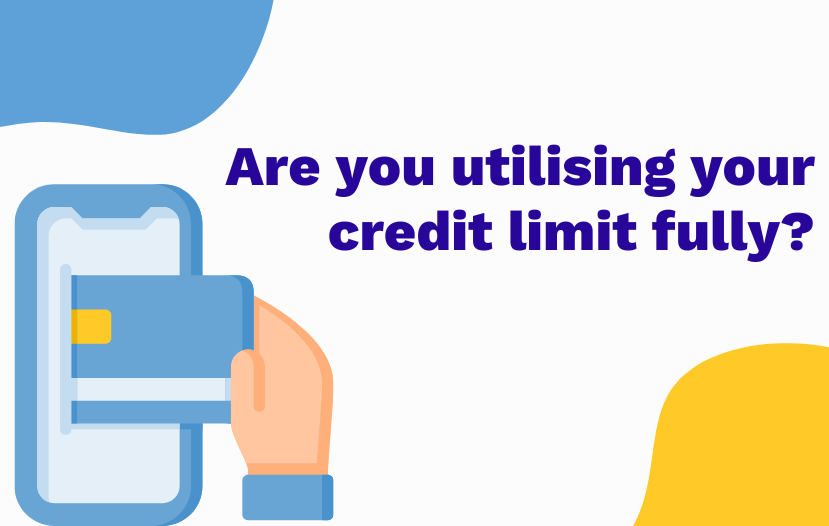Are you utilizing your credit limit fully?


One of the elements that may have an impact on your credit score is Credit Utilization Ratio. Therefore, it's critical to comprehend what is credit utilization ratio, how it functions, and how to manage it so that it benefits you.
Credit Utilization Ratio: What Is It?
The amount of revolving credit being used currently divided by total credit available to you is referred to as credit utilization. In other words, total amount owed divided by your credit limit. Your credit utilization ratio goes up and down with payments and purchases. A low credit utilization rate shows you're using less of your available credit.
How is the credit utilization ratio calculated?
(Total outstanding balance on all credit cards / Total credit limit) multiplied by 100 is the credit utilization ratio.
For instance, let's say you have two credit cards with a combined maximum of Rs. 1 lakh with an outstanding balance of Rs. 50,000 and Rs. 0 respectively.
The total balance on both cards (Rs. 50,000 + Rs. 0) is divided by the combined credit limit (Rs. 1 lakh), multiplied by 100, which comes out to be 50%. It means you are using 50% of the total credit that is available to you.
How much of a Credit Utilization Rate is good?
The ideal credit utilization ratio may be set by several credit agencies using a different cut-off. However, it's typically advised to keep your entire credit utilization percentage at or below 30%, which is an ideal credit use rate.
If the combined credit limit across all your credit cards is Rs. 1 lakh, for example, your total balance across all of your credit cards at any given moment should not be higher than Rs. 30,000.
How does credit usage operate?
Credit rating companies like CIBIL and Experian frequently take credit utilization ratio into account when calculating the credit score.
You are less reliant on credit if you have a low credit usage ratio. This gives credit bureaus the impression that you have good credit management skills and stick to your spending budget. This ultimately aids in raising your credit score. Additionally, having a high credit score makes it much simpler for you to obtain other credit lines, such as personal, home, and vehicle loans.
On the other hand, a high utilization ratio can indicate to a prospective creditor that you are having trouble handling your money. As a result, you might not be eligible for a loan at all.
How can you lower your credit usage ratio?
The financial practices listed below could improve your score.
Spend within your card's limit: You don't have to utilize your credit card to the maximum extent just because it has a greater limit. Keep in mind the 30-70 guidelines and make an effort to keep your spending within that range.
Try to balance it with your other credit cards if you go over the 30% limit on one card. Use them as little as possible so that the average use falls below 30%, or refrain from using them all together until the debt is paid in full.
Pay the balances in full: Regardless of how much you charge on your credit card, make sure you pay off the entire balance in full each month. Keep your unpaid balance as low as you can, even while you're not paying in full, to get a cheap rate.
Keeping some credit card accounts without a balance is another easy strategy to maintain a low credit usage ratio. This implies, if at all possible, avoid using one or two of your cards in the next few months. Your total credit limit will automatically increase as a result, lowering your use rate.
Credit Limit Problem
A high credit utilization ratio indicates that you are probably going to max out the credit card. The majority of credit bureaus take the credit card utilization percentage into account when calculating a credit score. When issuing credit cards, banks like to exercise caution by keeping the credit limit on the low side. Depending on usage, banks evaluate credit card limits every 12 to 18 months.
When banks offer to increase the credit card limit, you must take them up on their offer. It's advised not to utilize more than 30% to 40% of your credit card's available limit. Your bank will review your credit report when you ask for a larger credit card limit so they may analyse your credit situation and assess your credit eligibility.
Advantages of raising the credit limit
Boosts your credit score: Since your debt-to-credit utilization ratio drops significantly, increasing the credit limit on your credit cards may assist. By increasing your credit limit, you'll have more room to spend while still having an upper safety net. Your credit score will rise as a result.
Boosts your purchase power: Bigger the credit limit, the more purchasing power. This makes it possible for you to make significant purchases, such as white goods, and to pay the remaining balance through EMIs.
Rapid loan acquisition: As your credit score rises and your payment history becomes impeccable, you will be in a better position to bargain for loans with reduced interest rates. Your chances of being approved for new loans or credit cards increase with a higher credit score.
End Note
There are many benefits to having multiple credit cards, but only if you manage them responsibly. Track your expenses and payments to keep your credit usage ratio under control. Maintaining a low utilization ratio on all your credit cards will go a long way in improving your credit score.

